2003 FORD MUSTANG warning
[x] Cancel search: warningPage 145 of 256

3. Start the vehicle.
If it is necessary to use the above procedure to
move the gearshift lever, it is possible that a fuse
has blown or the vehicle’s brakelamps are not
operating properly. Refer toFuses and relaysin the
Roadside emergencieschapter.
Do not drive your vehicle until you verify
that the brakelamps are working.
If your vehicle gets stuck in mud or snow it may be
rocked out by shifting from forward and reverse
gears, stopping between shifts, in a steady pattern.
Press lightly on the accelerator in each gear.
Do not rock the vehicle if the engine is not at
normal operating temperature or damage to
the transmission may occur.
Do not rock the vehicle for more than a few
minutes or damage to the transmission and
tires may occur or the engine may overheat.
Always set the parking brake fully and make
sure the gearshift is latched in P (Park).
Turn the ignition to the LOCK position and remove
the key whenever you leave your vehicle.
If the parking brake is fully released, but the
brake warning lamp remains illuminated, the
brakes may not be working properly. See your
dealer or a qualified service technician.
Driving
145
Page 209 of 256
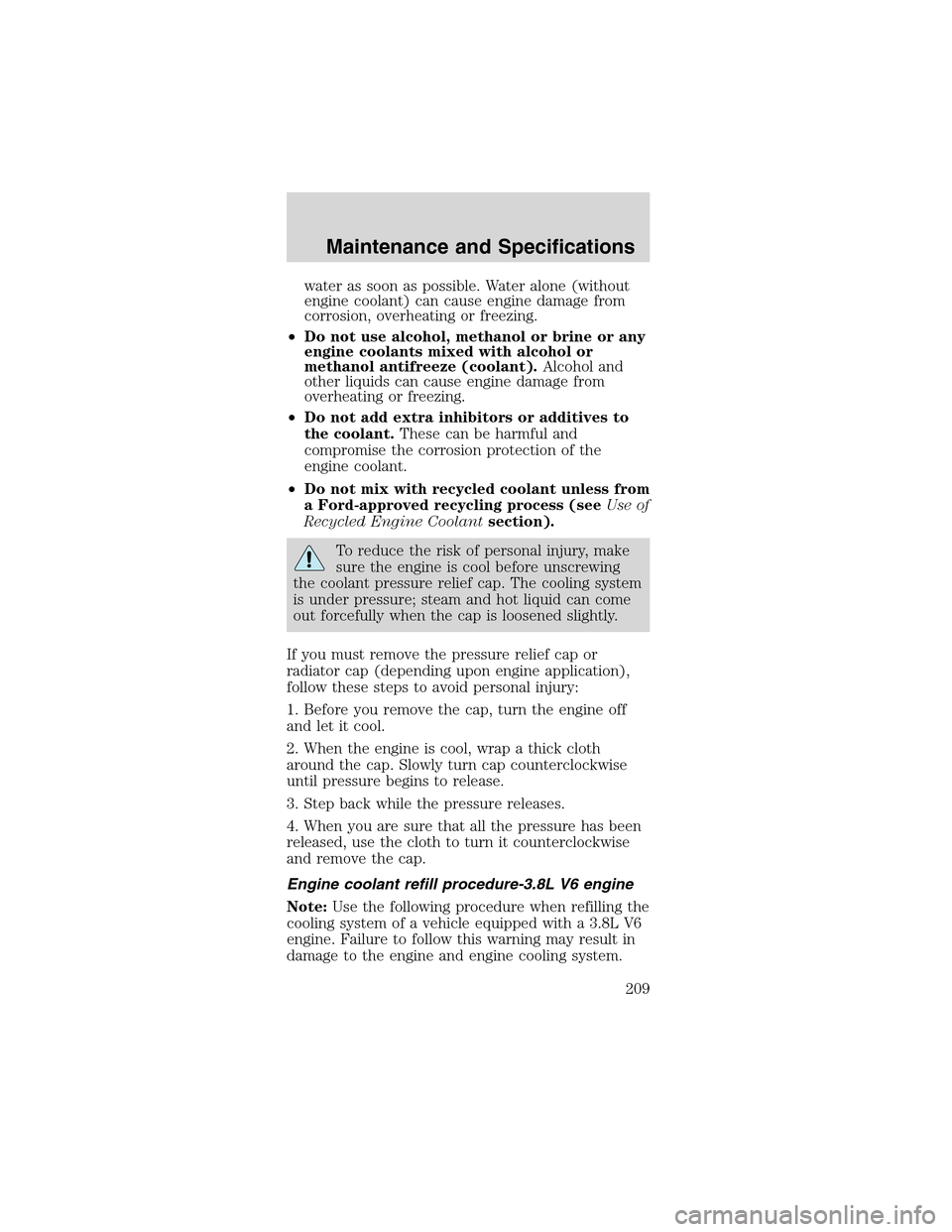
water as soon as possible. Water alone (without
engine coolant) can cause engine damage from
corrosion, overheating or freezing.
•Do not use alcohol, methanol or brine or any
engine coolants mixed with alcohol or
methanol antifreeze (coolant).Alcohol and
other liquids can cause engine damage from
overheating or freezing.
•Do not add extra inhibitors or additives to
the coolant.These can be harmful and
compromise the corrosion protection of the
engine coolant.
•Do not mix with recycled coolant unless from
a Ford-approved recycling process (seeUse of
Recycled Engine Coolantsection).
To reduce the risk of personal injury, make
sure the engine is cool before unscrewing
the coolant pressure relief cap. The cooling system
is under pressure; steam and hot liquid can come
out forcefully when the cap is loosened slightly.
If you must remove the pressure relief cap or
radiator cap (depending upon engine application),
follow these steps to avoid personal injury:
1. Before you remove the cap, turn the engine off
and let it cool.
2. When the engine is cool, wrap a thick cloth
around the cap. Slowly turn cap counterclockwise
until pressure begins to release.
3. Step back while the pressure releases.
4. When you are sure that all the pressure has been
released, use the cloth to turn it counterclockwise
and remove the cap.
Engine coolant refill procedure-3.8L V6 engine
Note:Use the following procedure when refilling the
cooling system of a vehicle equipped with a 3.8L V6
engine. Failure to follow this warning may result in
damage to the engine and engine cooling system.
Maintenance and Specifications
209
Page 216 of 256

Usethe following guidelines to avoid static build-up
when filling an ungrounded fuel container:
•Place approved fuel container on the ground.
•DO NOT fill a fuel container while it is in the
vehicle (including the cargo area).
•Keep the fuel pump nozzle in contact with the
fuel container while filling.
•DO NOT use a device that would hold the fuel
pump handle in the fill position.
Fuel Filler Cap
Your fuel tank filler cap has an indexed design with
a 1/8 turn on/off feature.
When fueling your vehicle:
1. Turn the engine off.
2. Carefully turn the filler cap counterclockwise 1/8
of a turn until it stops.
3. Pull to remove the cap from the fuel filler pipe.
4. To install the cap, align the tabs on the cap with
the notches on the filler pipe.
5. Turn the filler cap clockwise 1/8 of a turn until it
stops.
“Check Fuel Cap”illuminates when the ignition is
turned to the ON position to ensure your bulb is
working. When this light turns on, check the fuel
filler cap. Continuing to operate the vehicle with the
Check Fuel Cap light on, can activate the Service
Engine Soon warning. When the fuel filler cap is
properly re-installed, the light(s) will turn off after a
period of normal driving.It may take a long
period of time for the system to detect an
improperly installed fuel filler cap.
If you must replace the fuel filler cap, replace
it with a fuel filler cap that is designed for
your vehicle. The customer warranty may be
void for any damage to the fuel tank or fuel
system if the correct genuine Ford or
Motorcraft fuel filler cap is not used.
Maintenance and Specifications
216
Page 224 of 256
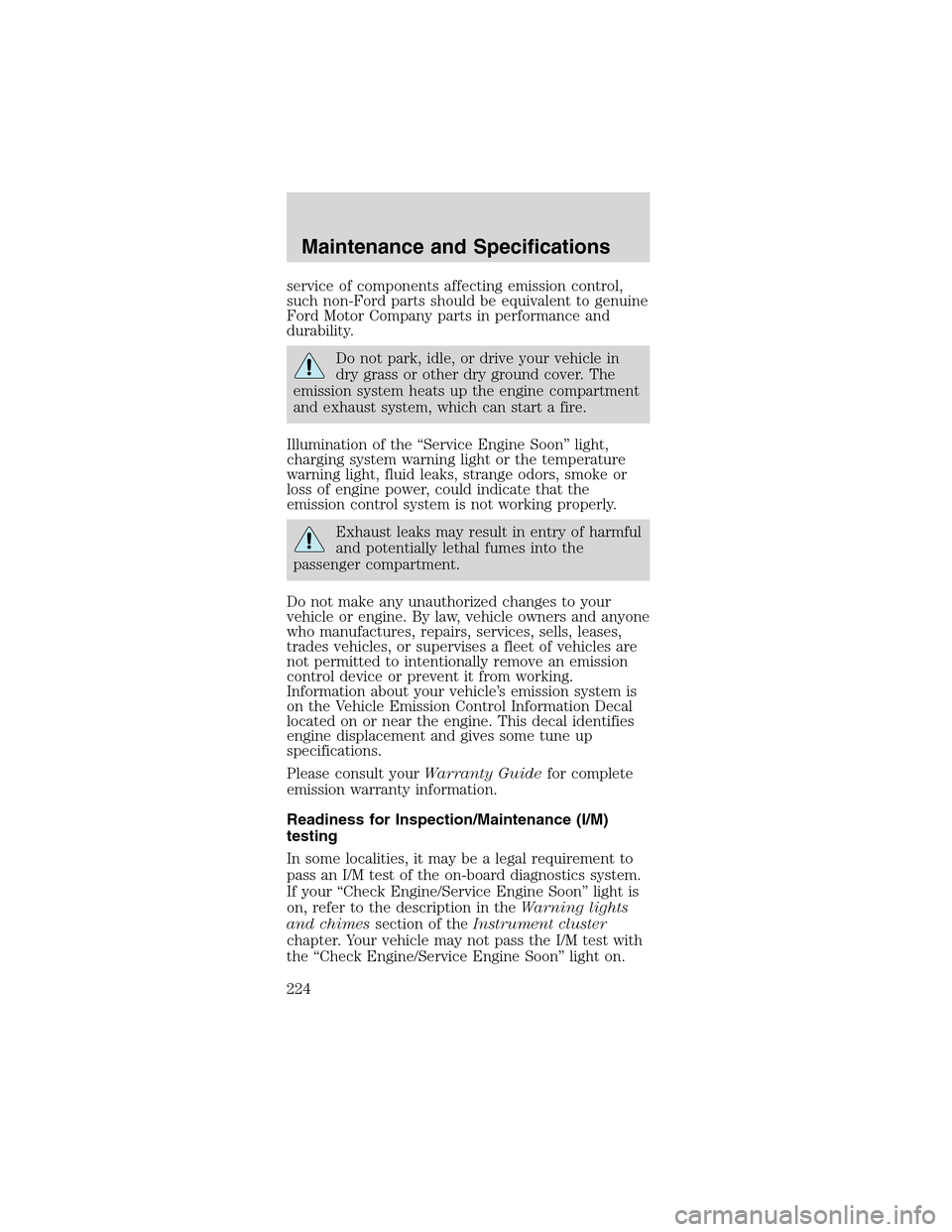
service of components affecting emission control,
such non-Ford parts should be equivalent to genuine
Ford Motor Company parts in performance and
durability.
Do not park, idle, or drive your vehicle in
dry grass or other dry ground cover. The
emission system heats up the engine compartment
and exhaust system, which can start a fire.
Illumination of the“Service Engine Soon”light,
charging system warning light or the temperature
warning light, fluid leaks, strange odors, smoke or
loss of engine power, could indicate that the
emission control system is not working properly.
Exhaust leaks may result in entry of harmful
and potentially lethal fumes into the
passenger compartment.
Do not make any unauthorized changes to your
vehicle or engine. By law, vehicle owners and anyone
who manufactures, repairs, services, sells, leases,
trades vehicles, or supervises a fleet of vehicles are
not permitted to intentionally remove an emission
control device or prevent it from working.
Information about your vehicle’s emission system is
on the Vehicle Emission Control Information Decal
located on or near the engine. This decal identifies
engine displacement and gives some tune up
specifications.
Please consult yourWarranty Guidefor complete
emission warranty information.
Readiness for Inspection/Maintenance (I/M)
testing
In some localities, it may be a legal requirement to
pass an I/M test of the on-board diagnostics system.
If your“Check Engine/Service Engine Soon”light is
on, refer to the description in theWarning lights
and chimessection of theInstrument cluster
chapter. Your vehicle may not pass the I/M test with
the“Check Engine/Service Engine Soon”light on.
Maintenance and Specifications
224
Page 248 of 256
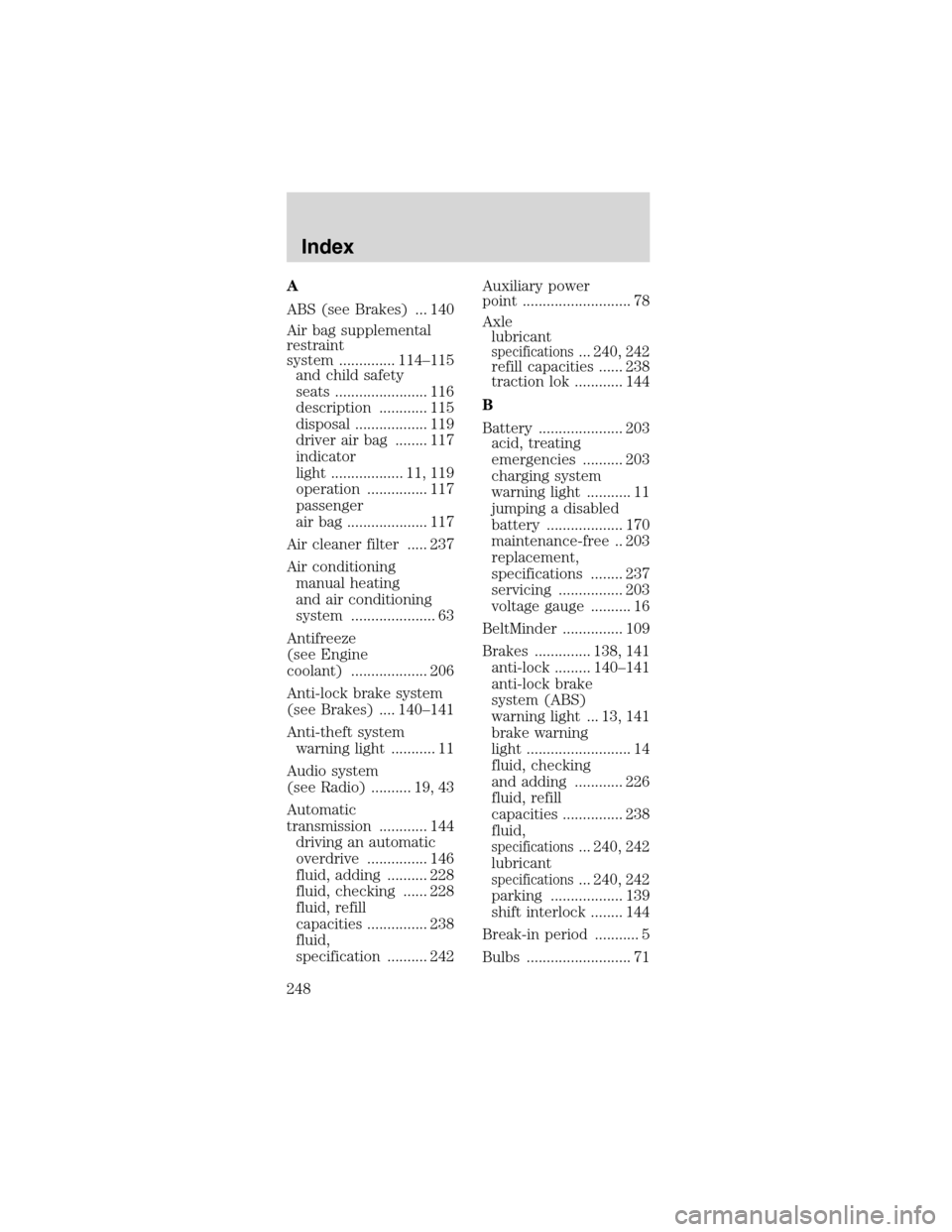
A
ABS (see Brakes) ... 140
Air bag supplemental
restraint
system .............. 114–115
and child safety
seats ....................... 116
description ............ 115
disposal .................. 119
driver air bag ........ 117
indicator
light .................. 11, 119
operation ............... 117
passenger
air bag .................... 117
Air cleaner filter ..... 237
Air conditioning
manual heating
and air conditioning
system ..................... 63
Antifreeze
(see Engine
coolant) ................... 206
Anti-lock brake system
(see Brakes) .... 140–141
Anti-theft system
warning light ........... 11
Audio system
(see Radio) .......... 19, 43
Automatic
transmission ............ 144
driving an automatic
overdrive ............... 146
fluid, adding .......... 228
fluid, checking ...... 228
fluid, refill
capacities ............... 238
fluid,
specification .......... 242Auxiliary power
point ........................... 78
Axle
lubricant
specifications... 240, 242
refill capacities ...... 238
traction lok ............ 144
B
Battery ..................... 203
acid, treating
emergencies .......... 203
charging system
warning light ........... 11
jumping a disabled
battery ................... 170
maintenance-free .. 203
replacement,
specifications ........ 237
servicing ................ 203
voltage gauge .......... 16
BeltMinder ............... 109
Brakes .............. 138, 141
anti-lock ......... 140–141
anti-lock brake
system (ABS)
warning light ... 13, 141
brake warning
light .......................... 14
fluid, checking
and adding ............ 226
fluid, refill
capacities ............... 238
fluid,
specifications... 240, 242
lubricant
specifications... 240, 242
parking .................. 139
shift interlock ........ 144
Break-in period ........... 5
Bulbs .......................... 71
Index
248
Page 250 of 256
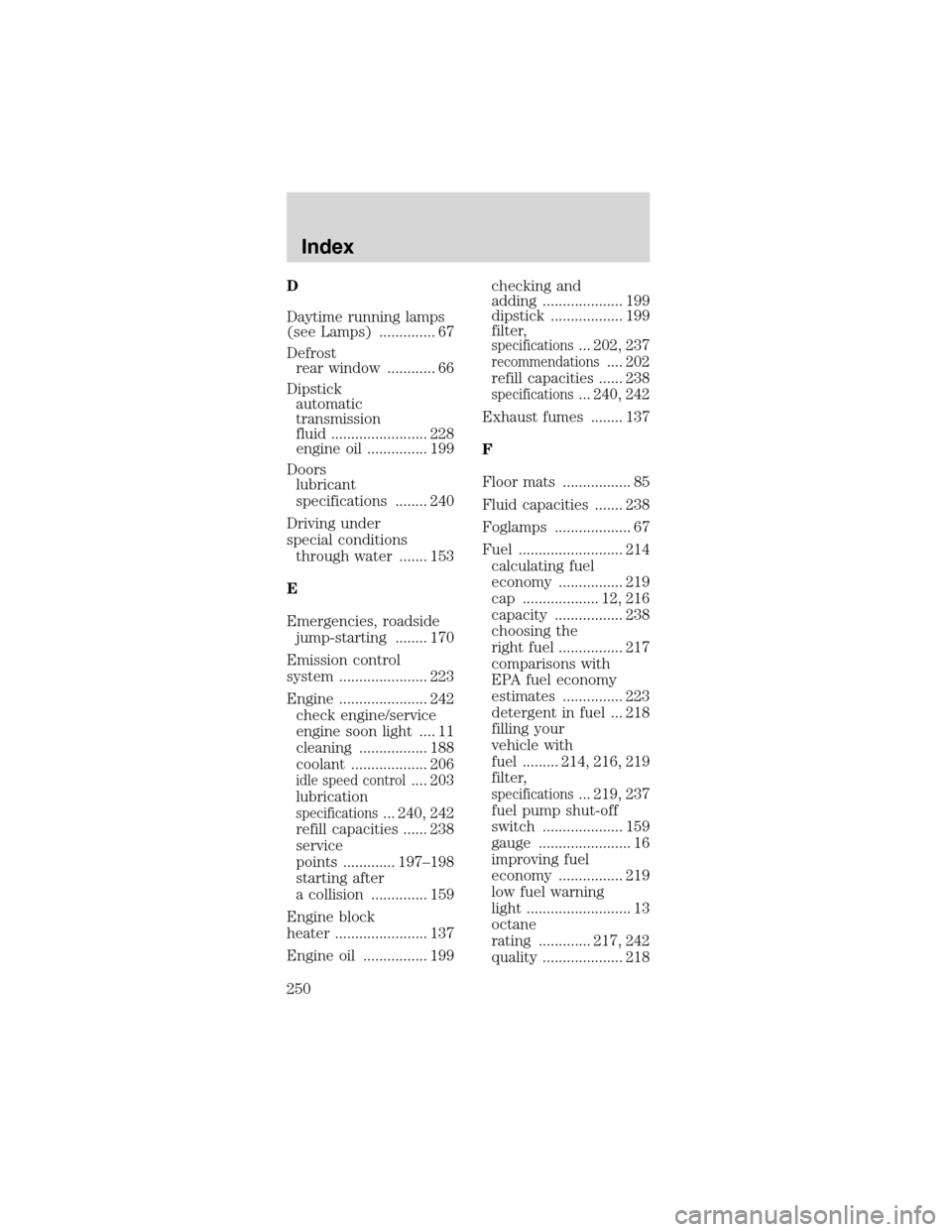
D
Daytime running lamps
(see Lamps) .............. 67
Defrost
rear window ............ 66
Dipstick
automatic
transmission
fluid ........................ 228
engine oil ............... 199
Doors
lubricant
specifications ........ 240
Driving under
special conditions
through water ....... 153
E
Emergencies, roadside
jump-starting ........ 170
Emission control
system ...................... 223
Engine ...................... 242
check engine/service
engine soon light .... 11
cleaning ................. 188
coolant ................... 206
idle speed control.... 203
lubrication
specifications... 240, 242
refill capacities ...... 238
service
points ............. 197–198
starting after
a collision .............. 159
Engine block
heater ....................... 137
Engine oil ................ 199checking and
adding .................... 199
dipstick .................. 199
filter,
specifications... 202, 237
recommendations.... 202
refill capacities ...... 238
specifications... 240, 242
Exhaust fumes ........ 137
F
Floor mats ................. 85
Fluid capacities ....... 238
Foglamps ................... 67
Fuel .......................... 214
calculating fuel
economy ................ 219
cap ................... 12, 216
capacity ................. 238
choosing the
right fuel ................ 217
comparisons with
EPA fuel economy
estimates ............... 223
detergent in fuel ... 218
filling your
vehicle with
fuel ......... 214, 216, 219
filter,
specifications... 219, 237
fuel pump shut-off
switch .................... 159
gauge ....................... 16
improving fuel
economy ................ 219
low fuel warning
light .......................... 13
octane
rating ............. 217, 242
quality .................... 218
Index
250
Page 251 of 256

running out
of
fuel ......................... 218
safety information
relating to
automotive fuels ... 214
Fuses ........................ 160
G
Gas cap
(see Fuel cap) ... 12, 216
Gas mileage
(see
Fuel economy) ........ 219
Gauges ....................... 15
battery voltage
gauge ....................... 16
engine coolant
temperature
gauge ....................... 15
engine oil pressure
gauge ....................... 16
fuel gauge ................ 16
odometer ................. 17
speedometer ........... 17
tachometer .............. 17
trip odometer .......... 18
GAWR (Gross Axle
Weight Rating) ........ 154
definition ............... 154
driving with a
heavy load ............. 154
location .................. 154
GVWR (Gross Vehicle
Weight Rating) ........ 154
calculating ............. 154
definition ............... 154
driving with a
heavy load ............. 154
location .................. 154H
Hazard flashers ....... 158
Head restraints ......... 99
Headlamps ................. 67
aiming ................ 68–69
bulb specifications .. 71
daytime running
lights ........................ 67
flash to pass ............ 68
high beam ......... 10, 68
replacing bulbs ....... 72
turning on and off .. 67
warning chime ........ 15
Heating
heating and air
conditioning
system ..................... 63
Hood ........................ 196
I
Ignition ............. 133, 242
removing the key .. 153
Infant seats (see
Safety seats) ........... 123
Inspection/maintenance
(I/M) testing ............ 224
Instrument panel
cleaning ................. 190
cluster ...................... 10
lighting up panel
and interior ............. 68
J
Jack .......................... 165
positioning ............. 165
storage ................... 165
Index
251
Page 252 of 256
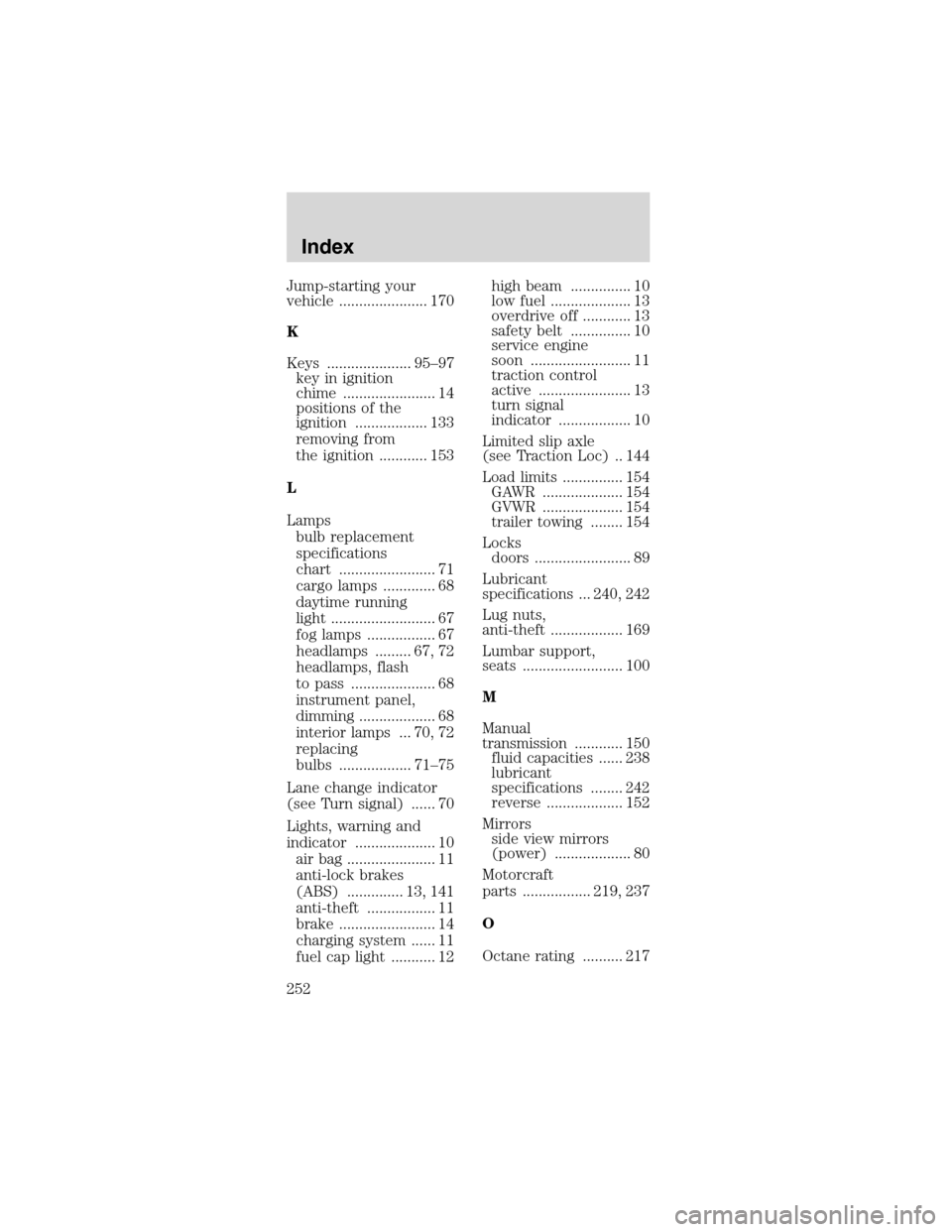
Jump-starting your
vehicle ...................... 170
K
Keys ..................... 95–97
key in ignition
chime ....................... 14
positions of the
ignition .................. 133
removing from
the ignition ............ 153
L
Lamps
bulb replacement
specifications
chart ........................ 71
cargo lamps ............. 68
daytime running
light .......................... 67
fog lamps ................. 67
headlamps ......... 67, 72
headlamps, flash
to pass ..................... 68
instrument panel,
dimming ................... 68
interior lamps ... 70, 72
replacing
bulbs .................. 71–75
Lane change indicator
(see Turn signal) ...... 70
Lights, warning and
indicator .................... 10
air bag ...................... 11
anti-lock brakes
(ABS) .............. 13, 141
anti-theft ................. 11
brake ........................ 14
charging system ...... 11
fuel cap light ........... 12high beam ............... 10
low fuel .................... 13
overdrive off ............ 13
safety belt ............... 10
service engine
soon ......................... 11
traction control
active ....................... 13
turn signal
indicator .................. 10
Limited slip axle
(see Traction Loc) .. 144
Load limits ............... 154
GAWR .................... 154
GVWR .................... 154
trailer towing ........ 154
Locks
doors ........................ 89
Lubricant
specifications ... 240, 242
Lug nuts,
anti-theft .................. 169
Lumbar support,
seats ......................... 100
M
Manual
transmission ............ 150
fluid capacities ...... 238
lubricant
specifications ........ 242
reverse ................... 152
Mirrors
side view mirrors
(power) ................... 80
Motorcraft
parts ................. 219, 237
O
Octane rating .......... 217
Index
252